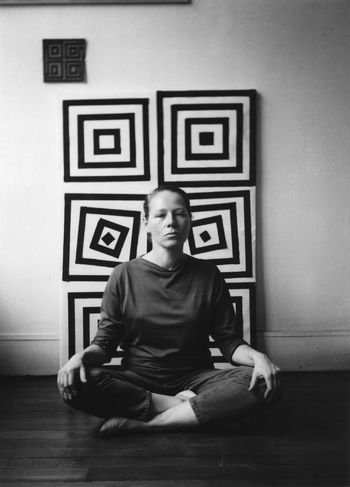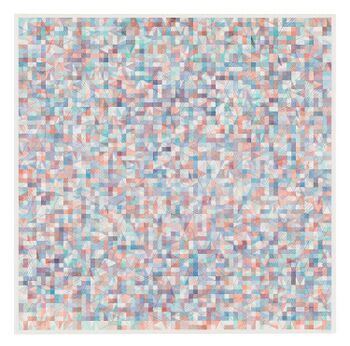Vera Molnár
Vera Molnár (5 January 1924, Budapest - 7 December 2023, Paris) was a Hungarian-French visual artist and a pioneer of algorithmic art.
Fascinated by the tradition of European Constructivism, Vera Molnár contributed to its development by introducing a unique minimalist plastic grammar based on the rules of computer programming. After completing her studies at the School of Fine Arts in Budapest (1942-1947), she moved to Paris. Together with other artists working in geometric abstraction who'd emigrated to Paris (such as Julio Le Parc), Molnár founded the collective GRAV (Groupe de Recherche d'Art Visuel), which used artistic means to study optics. Later she was also a member of the Art et Informatique group.
She began painting at the age of twelve, her first subjects being nymphs and trees, inspired by an uncle. Soon moved on to more geometric subjects, and in 1968 began working with computers. Her work during this period focused on breaking up repeating units, often expressed as a series of increasingly fractured images. In order to eliminate what she called 'mental-cultural ready-mades', she employed various programmatic games and mathematical principles to produce series of works guided by a unifying search for the invisible. Even in her earliest works based on the 'imagined machine', Molnar challenged the position of the artist as the sole creator of art. While other Kinetists questioned the role of the artist by involving the audience in the creative process, Molnar shared her creative responsibilities with machines. The machines initially consisted of sets of algorithms generated in her imagination, before being replaced by actual computer software.
Vera Molnar held that the computer can serve four purposes. The first is its technical promise - it expands the realm of the possible with its infinite variety of forms and colours, and especially with the development of virtual space. Secondly, the computer can satisfy the desire for artistic innovation and thus lighten the burden of traditional cultural forms. It can make the accidental or the random subversive in order to create an aesthetic shock and to break the systematic and the symmetrical. A virtual database can be created for this purpose. Thirdly, the computer can encourage the mind to work in new ways. Molnar believed that artists often move too quickly from the idea to the realisation of the work. The computer can create images that can be held longer, not only in the database but also in the artist's imagination. Finally, Molnar thought that the computer could help the artist by measuring the physiological responses of the audience, such as their eye movements, thus bringing the creative process closer to its products and their effects. (based on source and source)
Publications[edit]
- "Toward Aesthetic Guidelines for Painting with the Aid of a Computer", Leonardo 8:3, Summer 1975, pp 185-189. [1]
- "My Mother's Letters: Simulation by Computer", Leonardo 28:3, Jun 1995, pp 167-170. [2]
Catalogues[edit]
- Vera Molnar, ed. Barbara Nierhoff, Budapest: Vintage Galeria, 2018. (Hungarian)/(English)
Interviews[edit]
- "Vera Molnar in conversation with Hans Ulrich Obrist", in Bookmarks: Revisiting Hungarian Art of the 1960s and 1970s, eds. Hans Ulrich Obrist and András Szánto, Koenig Books, 2018, pp 76-87.
- "Vera Molnár: ‘I have no regrets. My life is squares, triangles, lines’", Studio International, Jun 2018, 43 min. Video.
- "An Interview with Vera Molnar. The pioneering artist speaks to Zsofi Valyi-Nagy about NFTs, generative art, and the machine imaginaire", Right Click Save, Aug 2022; repr. in Right Click Save: The New Digital Art Community, ed. Alex Estorick, Berlin: Vetro Editions, 2024.
Literature[edit]
- Frank Popper, "Visualization, Cultural Mediation and Dual Creativity", Leonardo 29:4, Aug 1996.
- Adam Jasper "Vera Molnar", Frieze 170, Apr 2015. Exh. review.
- Zsofi Valyi-Nagy, "Vera Molnar: Weaving Variations", Holo: Emerging Trajectories in Art, Science and Technology, Apr 2022. Exhibition dossier.
- Zsofi Valyi-Nagy, Vera Molnar's Programmed Abstraction: Computer Graphics and Abstract Art in Postwar Europe, Chicago: University of Chicago, 2023. PhD thesis.
- Zsofi Valyi-Nagy, "Screenshots from the 1970s: Vera Molnar’s Experiments in Interactive Computing", in New Media in Art History: Tensions, Exchanges, Situations, eds. Melissa Rérat, Régine Bonnefoit, and Samuel Schellenberg, Berlin: De Gruyter, 2023.
- Zsofi Valyi-Nagy, "Between the Lines: The Art of Vera Molnar", Artforum 62:9, May 2024. Video interview.
Links[edit]
- Website
- AWARE: Archives of Women Artists, Research and Exhibitions
- CEAD database
- compArt database
- Digital Art Museum, [3]
- Retrospective, Beall Center for Art + Technology, Irvine, CA, 2022. Review: Kent (ArtReview). [4]
- Spalter Digital
- Ropac gallery, Biography
- Mayor Gallery
- https://murilopolese.github.io/RTP_SFPC_SUMMER20/research/Vera_Moln%C3%A1r.html
- https://observablehq.com/@wenrazhao2/assginment-1-the-art-of-the-grid
- Tributes: Agathe Hakoun, Valérie de Maulmin (Conaissance des arts), Francesca Franco (Leonardo), ArtReview, Artportal.hu.
- Wikipedia-FR

